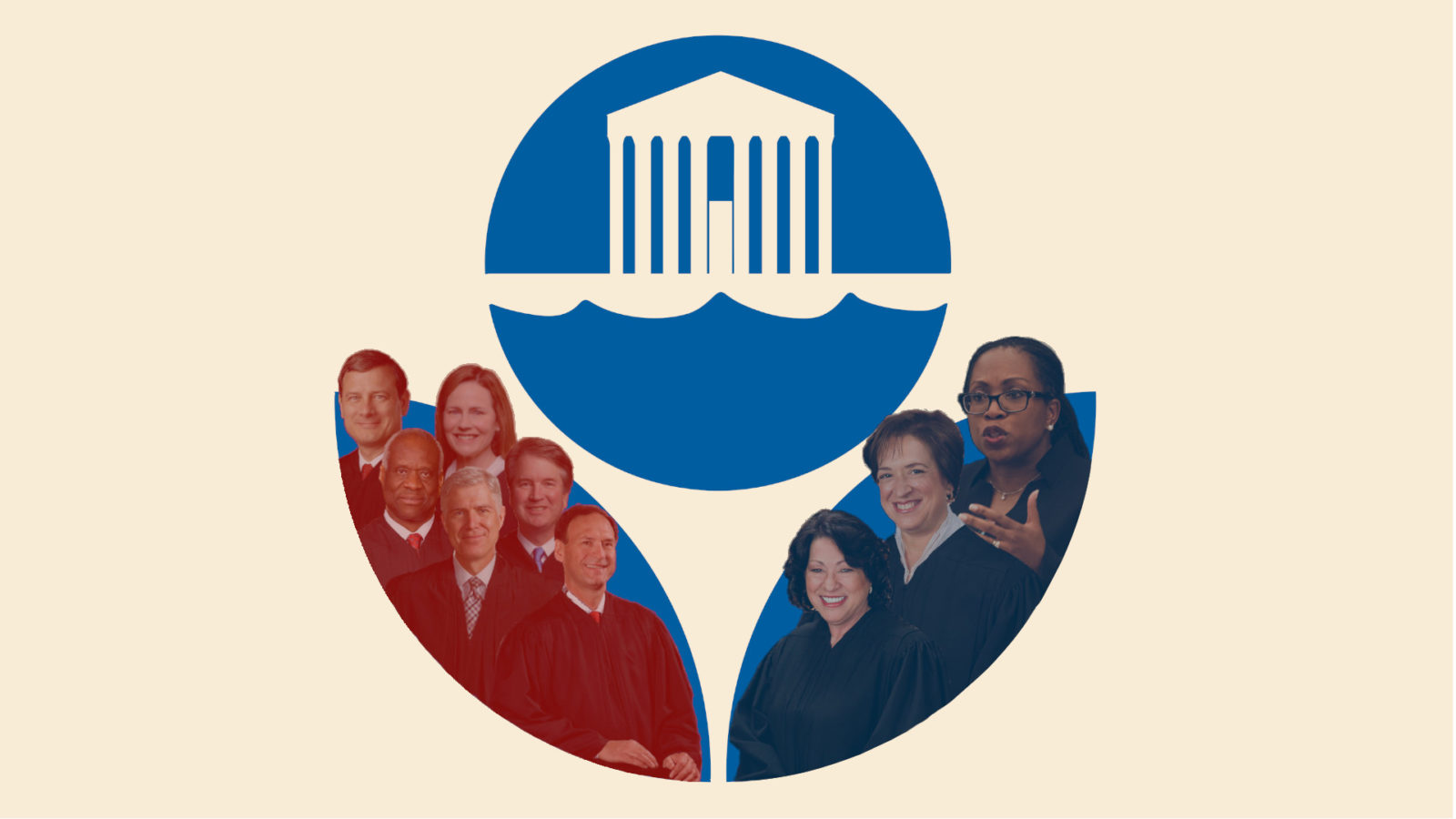Last week, the Senate Judiciary Committee confirmed Ketanji Brown Jackson, President Biden’s nomination to the country’s highest court. Jackson will be the first Black female U.S. Supreme Court Justice, and take the place of retiring Justice Stephen Breyer. Since Jackson was nominated by President Biden, it stands to reason she will lean towards more liberal opinions on the cases she will hear. While this doesn’t change the overall ideological makeup of the Supreme Court, Jackson’s appointment has important implications for legal disputes over climate and environmental policy. Though many cases don’t make the journey all the way up to the Supreme Court, it’s interesting to look at how Jackson’s confirmation could affect state climate policy and which cases to keep an eye on.
Judge Jackson’s Climate Record
Ketanji Brown Jackson’s addition to the court locks in a lifelong position for a liberal voice on the bench. During her judicial career, Jackson has had a mixed environmental record, siding with pro-environment groups as often as she’s sided against them. Legal experts say that Jackson tends to be a stickler for the administrative and procedural rules of a case, but there isn’t enough information to tell how pro-climate her opinions will be.
The Deepwater Horizon oil spill in 2010 spurred calls for increased accountability in the federal government. Jackson presided over a case brought against the Department of the Interior over issuing oil drilling permits. In Center for Biological Diversity v. Department of the Interior, Jackson ruled against environmental groups who sought to force the government to finalize their review of practices that could lead to future environmental disasters. The Department of the Interior was already reviewing their practice of issuing drilling permits before completing site-specific environmental studies, but this review had been going on for six years. The Center for Biological Diversity sued the Department of Interior to complete their review and announce the findings publicly. Judge Jackson ultimately ruled that the Department of the Interior had an obligation to review their practices, but was not mandated to actually complete the review, let alone announce the findings publicly. Jackson’s ruling was not based on pro-oil leanings, but on the strict wording of the National Environmental Policy Act, the law that forces agencies to evaluate their impacts on the environment. Jackson found that while The National Environmental Policy Act does require agencies to review their policies and procedures, it does not mandate them to conclude that review.
Then in 2016, Judge Jackson rejected a motion from the federal government to dismiss a suit from the territory of Guam over a U.S. Navy-created landfill on the island from the 1940’s. Guam asserted that the Navy should bear some responsibility for cleanup costs from the improperly sealed dump, but the Navy said that it was too late to seek compensation. Judge Jackson allowed the case to proceed, and eventually the Supreme Court unanimously ruled in favor of Guam, stating they had the right to pursue action against the federal government.
In possibly her highest profile environmental case as a federal judge, Jackson once again ruled against environmentalists who challenged the Trump administration’s construction of the border wall separating the U.S. and Mexico. The activists claimed that the wall’s construction would violate a number of environmental laws and should be stopped. Judge Jackson sided with the Trump administration, citing a 1996 law that prohibited judicial review of the waiving of environmental law when constructing border fences. Again, this ruling does not imply anti-environment leanings, but is further evidence of Jackson’s strict adherence to procedural rules and technical case details.
It’s not yet clear if Judge Jackson’s future rulings will further climate action. However, she has a strong record of adhering to administrative procedure in her rulings and fairly evaluating the merits of individual cases. And as the effects of climate change worsen, she’ll have no shortage of environmental disputes during her lifelong tenure on the Supreme Court.
The Supreme Court’s Future Climate Cases
While many cases won’t make it on the Supreme Court’s docket, the following are issues that may be decided by Judge Jackson and her colleagues in upcoming sessions.
Limiting the Environmental Protection Agency
The Environmental Protection Agency (EPA), which is more than 50 years old, has a wide reach and enforces standards of environmental laws and regulations. The agency is a powerful executive tool for reducing greenhouse gas emissions due to the effect climate change has on the environment. Recently, certain regulatory powers of the EPA have been under scrutiny from federal courts, including the Supreme Court, because of their impacts on the entire country. Restricting the EPA’s ability to regulate emissions could seriously weaken the executive branch’s climate solutions capabilities.
West Virginia v. Environmental Protection Agency and Texas v. Environmental Protection Agency
While West Virginia v. Environmental Protection Agency was heard before Judge Jackson joins the Supreme Court next session, it may provide insights on the court’s logic for future decisions regarding the EPA’s authority and open the door for similar cases.
West Virginia v. EPA revolves around a mostly extinct Obama-era climate regulation, the Clean Power Plan. This plan was supposed to be President Obama’s biggest climate policy, and among other things gave the EPA the authority to regulate greenhouse gas emissions from power plants. More than half of states sued the administration over this regulation, and in 2016 the Supreme Court actually blocked the plan until the lower courts could figure it out. The Clean Power Plan lay dormant until 2019 when the Trump administration formally repealed it and replaced the policy with a much weaker rule.
The Supreme Court now seems prepared to finally strike down the Clean Power Plan, with conservative justices arguing that it violates the court’s own “major questions doctrine.” This belief says that any regulation that has significant economic or political impacts should be halted unless Congress gives that agency the explicit authority to proceed. If the Clean Power Plan is found to violate this doctrine, the outcome could seriously weaken the EPA’s authority to regulate greenhouse gasses based on the notion that the regulations would have significant consequences.
During a time when Congress seems unlikely to pass strong climate policy, environmentalists have at least been hopeful that the Biden administration would take executive action. If the EPA can’t regulate greenhouse gas emissions, that takes away the stick and leaves only the carrot. It also opens up the possibility for the Supreme Court to get involved with other federal disputes with the EPA, such as Texas v. Environmental Protection Agency, which could again limit the agency’s ability to regulate emissions, this time in vehicles. It’s uncertain if this case would make it to the highest court, but as a high profile case involving a federal agency’s ability to broadly regulate greenhouse gas emissions, it seems likely.
Sackett v. Environmental Protection Agency
Jackson is expected to be on the Supreme Court when it hears Sackett v. Environmental Protection Agency, another case that would have major implications for the reach of the federal agency. Sackett v. EPA is a case regarding the authority of the Clean Water Act, a 1972 law that established pollution protections and clean water standards for “waters of the United States.” Among other things, the Clean Water Act made it illegal to discharge pollutants into the country’s waters unless you had a permit.
The outcome of Sackett v. EPA could potentially weaken the reach of the Clean Water Act when it comes to property rights. In this case, a couple is attempting to build a home on their property near Priest Lake, Idaho. The Environmental Protection Agency says that because there are wetlands on the lot and it is adjacent to Priest Lake, the land is under the jurisdiction of the Clean Water Act and thus the owners need a permit to build there. The main question surrounding this case is one that hasn’t really been answered in any of the previous challenges to the law: What are considered to be “waters of the United States”?
In 2006, a litmus test, known as the Rapanos rule, emerged from another case saying that the Clean Water Act covers wetlands with a “significant nexus” to other navigable bodies of water. The Sacketts claim that the courts cannot agree on how the Rapanos rule is applied to land like theirs, and that because there is no surface connection between their wetlands and Priest Lake, the Clean Water Act should not apply. Business groups have long sought to get rid of the Rapanos rule and prefer that the courts order that the Clean Water Act only protects water connected to a river, lake, or other waterway.
A ruling in favor of the Idaho couple could strengthen property owner rights and weaken environmental protections. While this case strictly surrounds the definition of the country’s water, the downstream consequences are profound. If disconnected wetlands are determined to not be included in the Clean Water Act’s domain, it would mean that the EPA would be blocked from regulating them in the future. The ruling would include wetlands separated on the surface from any navigable body of water, even if they are connected underground. This change could weaken the current protection of wetlands, which provide important benefits including natural carbon sequestration and buffering sea level rise.
Climate in the Courts
Because the effects of climate change are projected to worsen, there will be more disputes surrounding climate legislation and regulations. Along with those disputes, there will be cases that seek to clarify who should be held accountable for climate change, how to protect future generations, and what actions states can take.
Climate Liability
Across the country, several state and local governments are seeking to hold polluters accountable for contributing to climate change, and force them to pay for the solutions. These so-called climate liability cases are a topic that the Supreme Court may take up. The suits are filed against fossil fuel companies in state courts, but some industry lawyers are seeking to move the cases to the federal level, where they hope to find more friendly judges.
In May 2021, the Supreme Court sent back a number of climate liability cases to appellate judges with instructions to take additional factors into consideration when deciding if the case should be heard in federal or state courts. In one of them, BP PLC v. Mayor and City Council of Baltimore, the Supreme Court sided with fossil fuel industry lawyers that federal appeals courts should be able to evaluate whether or not a case should be remanded to a lower court. In this case, the City of Baltimore is suing BP and claiming that they knowingly harmed the environment with fossil fuel production and attempted to hide it. It should be noted that the Supreme Court did not side with BP on the merits of this case, only the procedural question of which level of court it belongs in.
Youth Climate Cases
There will also be an increased number of cases from youth climate activists who assert that their states are not adequately protecting their futures by allowing fossil fuel development. These lawsuits argue that governments have a human rights obligation to protect their residents from the harmful effects of climate change. These cases are rare in the U.S., but the first youth-led climate trial has been announced in Held v. State of Montana. In this case, the plaintiffs argue that the state’s fossil fuel practices infringe on their constitutional right to a clean and healthy environment. The trial date has been set for February 6, 2023.
There’s also been some international success with these types of suits. For example, 25 young Colombian plaintiffs argued that the government’s failure to prevent deforestation threatened their rights and future generations. The court agreed and ordered the government to create a plan to reduce deforestation.
State Climate Action
The Supreme Court may also have to weigh in on what actions states can take to stop climate change, and how aggressive those actions can be. For instance, if a state were to pass a law that prevents fossil fuel infrastructure from being built, it’s possible this could be blocked by the Supreme Court. A part of the Constitution known as the Commerce Clause prevents states from unfairly obstructing the sale of goods or services across their borders. An example of this would be if New York, for instance, charged a border tax on any apples that came into the state to benefit its own fruit industry and harm other states. Fossil fuel interests have recently claimed that restricting their ability to engage in economic activity, like building pipelines, would violate the Commerce Clause. Legal experts are unsure whether the Commerce Clause argument will be successful in all of the cases, but again the Supreme Court will likely hear some of them.
As more people feel the effects of climate change, the Supreme Court will be forced to weigh in on the legal aspects. Ketanji Brown Jackson’s appointment may not affect the cases currently on the docket, but since this is a lifelong post, she’ll be faced with decisions that guide the country’s future. It’s important for states to be aware of how this particular court could lean on climate cases and potentially determine the actions that they can take to curb emissions.
References:
-
Biden has picked his Supreme Court nominee. Here’s her environmental record., Grist, 2/25/2022
-
The jury’s out on Jackson’s climate views, E&E News, 2/28/2022
-
Center for Biological Diversity v. Ryan Zinke, 260 F.3d 11 (D.D.C. 2017)
-
Summary of the National Environmental Policy Act, Environmental Protection Agency, 9/28/2021
-
Gov’t of Guam v. United States, No. 1:17-cv-2487 (KBJ) (D.D.C. Feb. 28, 2019)
-
Ordot Landfill, Environmental Protection Agency, 2022
-
Center for Biological Diversity v. Kevin McAleenan, 404 F.3d 218 (D.D.C. 2019)
-
West Virginia v. Environmental Protection Agency, SCOTUSblog, 2022
-
Supreme Court Deals Blow to Obama’s Efforts to Regulate Coal Emissions, The New York Times, 2/9/2016
-
Trump’s EPA just replaced Obama’s signature climate policy with a much weaker rule, Vox, 6/19/2019
-
The Supreme Court appears eager to gut the EPA, but can’t figure out how to do it, Vox, 2/28/2022
-
Texas v. EPA, Sabin Center for Climate Change Law, 2022
-
Sackett v. Environmental Protection Agency, SCOTUSblog, 2022
-
Summary of the Clean Water Act, Environmental Protection Agency, 10/22/2021
-
Supreme Court takes EPA case that could narrow Clean Water Act, The Washington Post, 1/24/2022
-
2008 Rapanos Guidance and Related Documents under CWA Section 404, Environmental Protection Agency, 9/7/2021
-
Climate Change Cases May Be Less Likely Litigated in State Court Following SCOTUS Ruling, National League of Cities, 2022
-
Date set for first youth-led climate trial in U.S. history, NBC News, 2/7/2022
-
How youth climate court cases became a global trend, Climate Home News, 4/30/2021
-
Commerce Clause, Legal Information Institute
-
Commerce Clause, Sabin Center for Climate Change Law, 2022
-
This Clause in the US Constitution Is Being Wielded to Attack Climate Change Policies, Sightline Institute, 10/1/2019









